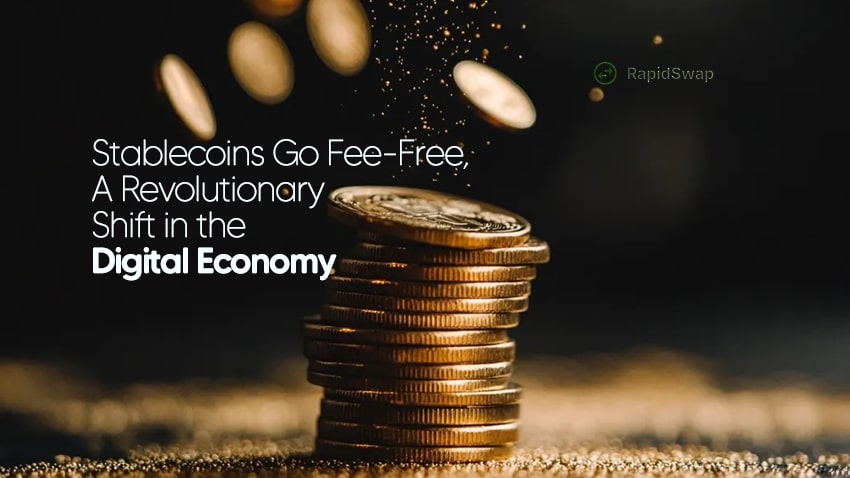In recent years, stablecoins have emerged as one of the most important innovations in the cryptocurrency space. These digital currencies, pegged to the value of a stable asset like the US dollar, have transformed how we think about financial transactions in a globalized world. However, one of the major barriers to widespread adoption has been transaction fees, which could vary widely depending on the network used. The latest breakthrough in stablecoin technology—fee-free transactions—represents a significant shift in how we engage with digital currencies.
What are Stablecoins?
Stablecoins are a type of cryptocurrency designed to minimize volatility by being backed by a reserve asset such as a fiat currency (USD, EUR, etc.) or commodities like gold. Unlike traditional cryptocurrencies like Bitcoin or Ethereum, which can experience wild price swings, stablecoins offer the benefits of blockchain technology while maintaining price stability. They are widely used in cross-border payments, remittances, and decentralized finance (DeFi) applications.
The Problem: Transaction Fees
Despite their many advantages, one issue that has hindered the adoption of stablecoins is the cost of transacting. Fees on certain blockchain networks can be significant, particularly during periods of high demand. These costs make it less attractive for users who wish to transfer small amounts of money or make frequent transactions. For example, using stablecoins for micropayments or regular day-to-day transactions could quickly become expensive due to cumulative fees.
The Solution: Fee-Free Stablecoin Transactions
Now, with recent advancements in blockchain efficiency and the growing competition between networks, fee-free transactions have become a reality. Several blockchain platforms and stablecoin issuers have introduced this option to eliminate transaction fees for users. This development can be a game-changer, particularly for industries such as remittances, online commerce, and decentralized finance, where every cent counts.
Let’s break down why this is so important:
- Accessibility for All: Removing transaction fees opens the doors for a much broader audience to participate in the digital economy. Whether you are sending $5 or $5000, the cost remains the same—zero. This makes stablecoins an even more appealing option for people in developing countries where access to traditional banking is limited, but access to digital technology is growing.
- Boosting Adoption: The removal of fees could drive greater adoption of stablecoins for everyday transactions. Merchants and consumers alike can benefit from fee-free payments, whether for online shopping or peer-to-peer transfers. The fee-free model brings stablecoins closer to being a seamless and intuitive payment method.
- Decentralized Finance (DeFi) Revolution: The fee-free nature of stablecoin transactions is likely to have a significant impact on the DeFi sector. It can drastically reduce the cost of engaging with DeFi protocols, where transaction fees can sometimes eat into profits or make it uneconomical to participate. Fee-free stablecoins will allow users to interact with lending, borrowing, and yield farming services without worrying about the cost of moving funds.
- Remittances and Global Transfers: One of the biggest potential beneficiaries of fee-free stablecoin transactions is the global remittance market. The current remittance system, which often involves high fees and delays, could be disrupted by fee-free stablecoin solutions. People sending money to family members across borders could now do so almost instantly and at zero cost.
- Encouraging Innovation: With the removal of fees, developers and companies are more likely to innovate around stablecoin applications, driving new use cases in payments, decentralized applications (dApps), and beyond. The shift could also pave the way for stablecoins to become the standard for online micropayments, where traditional credit card fees would have previously been prohibitive.
What’s Next?
Fee-free transactions represent a huge step forward for stablecoins, but challenges remain. For one, the underlying blockchain networks still need to be sustainable. Some worry that if the cost of maintaining a blockchain falls entirely on validators or stakers, network security could be compromised. In response, blockchain networks are looking into innovative ways to incentivize validators while keeping user costs low, such as through staking rewards or alternative consensus mechanisms.
In addition, regulatory concerns around stablecoins continue to evolve. As they become more widely used, governments and regulators may seek to establish clearer guidelines around stablecoin issuance and use, particularly as it pertains to anti-money laundering (AML) and know-your-customer (KYC) requirements.
The introduction of fee-free stablecoin transactions marks a pivotal moment in the evolution of the digital economy. It makes stablecoins more accessible, useful, and appealing to a global audience. Whether you are sending remittances, making online purchases, or participating in DeFi, fee-free stablecoins could become the backbone of the future financial system.
As we continue to see innovations in the blockchain space, the role of stablecoins is only going to grow. By removing the friction of transaction costs, this new development may well be the tipping point that brings stablecoins into mainstream use, transforming the way we think about money in a digital age.

